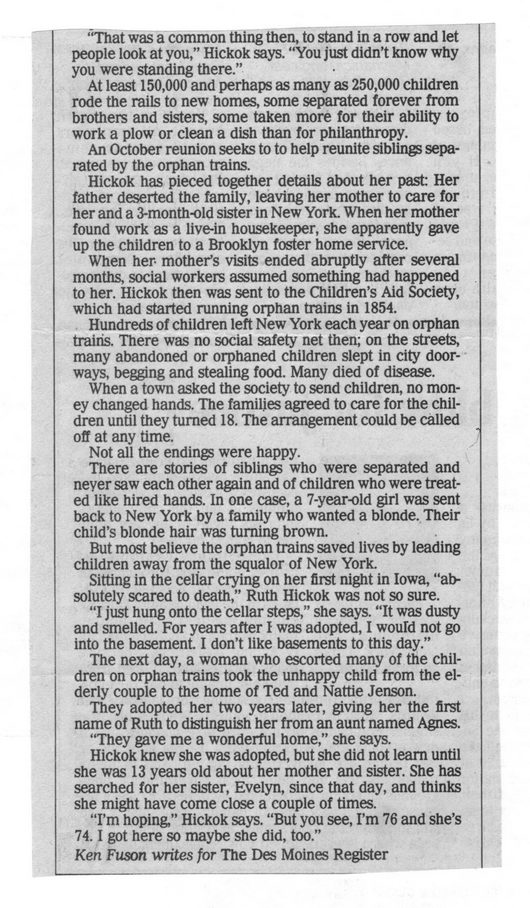This text was obtained via automated optical character recognition.
It has not been edited and may therefore contain several errors.
“That was a common thing then, to stand in a row and let people look at you,” Hickok says. “You just didn’t know why you were standing there.” At least 150,000 and perhaps as many as 250,000 children rode the rails to new homes, some separated forever from brothers and sisters, some taken more for their ability to work a plow or clean a dish than for philanthropy. An October reunion seeks to to help reunite siblings separated by the orphan trains. Hickok has pieced together details about her past: Her father deserted the family, leaving her mother to care for her and a 3-month-old sister in New York. When her mother found work as a live-in housekeeper, she apparently gave up the children to a Brooklyn foster home service. When her mother’s visits ended abruptly after several months, social workers assumed something had happened to her. Hickok then was sent to the Children’s Aid Society, which had started running orphan trains in 1854. Hundreds of children left New York each year on orphan trains. There was no social safety net then; on the streets, many abandoned or orphaned children slept in city doorways, begging and stealing food. Many died of disease. When a town asked the society to send children, no money changed hands. The families agreed to care for the children until they turned 18. The arrangement could be called off at any time. Not all the endings were happy. There are stories of siblings who were separated and neyer saw each other again and of children who were treated like hired hands. In one case, a 7-year-old girl was sent back to New York by a family who wanted a blonde. Their child’s blonde hair was turning brown. But most believe the orphan trains saved lives by leading children away from the squalor of New York. Sitting in the cellar crying on her first night in Iowa, “absolutely scared to death,” Ruth Hickok was not so sure. “I just hung onto the cellar steps,” she says. “It was dusty and smelled. For years after I was adopted, I would not go into the basement I don’t like basements to this day.” The next day, a woman who escorted many of the children on orphan trains took the unhappy child from the elderly couple to the home of Ted and Nattie Jenson. They adopted her two years later, giving her the first name of Ruth to distinguish her from an aunt named Agnes. “They gave me a wonderful home,” she says. Hickok knew she was adopted, but she did not learn until she was 13 years old about her mother and sister. She has searched for her sister, Evelyn, since that day, and thinks she might have come close a couple of times. “I’m hoping,” Hickok says. “But you see, I’m 76 and she’s 74.1 got here so maybe she did, too.” Ken Fuson writes for The Des Moines Register

Orphan Train Riders of BSL Document (017)